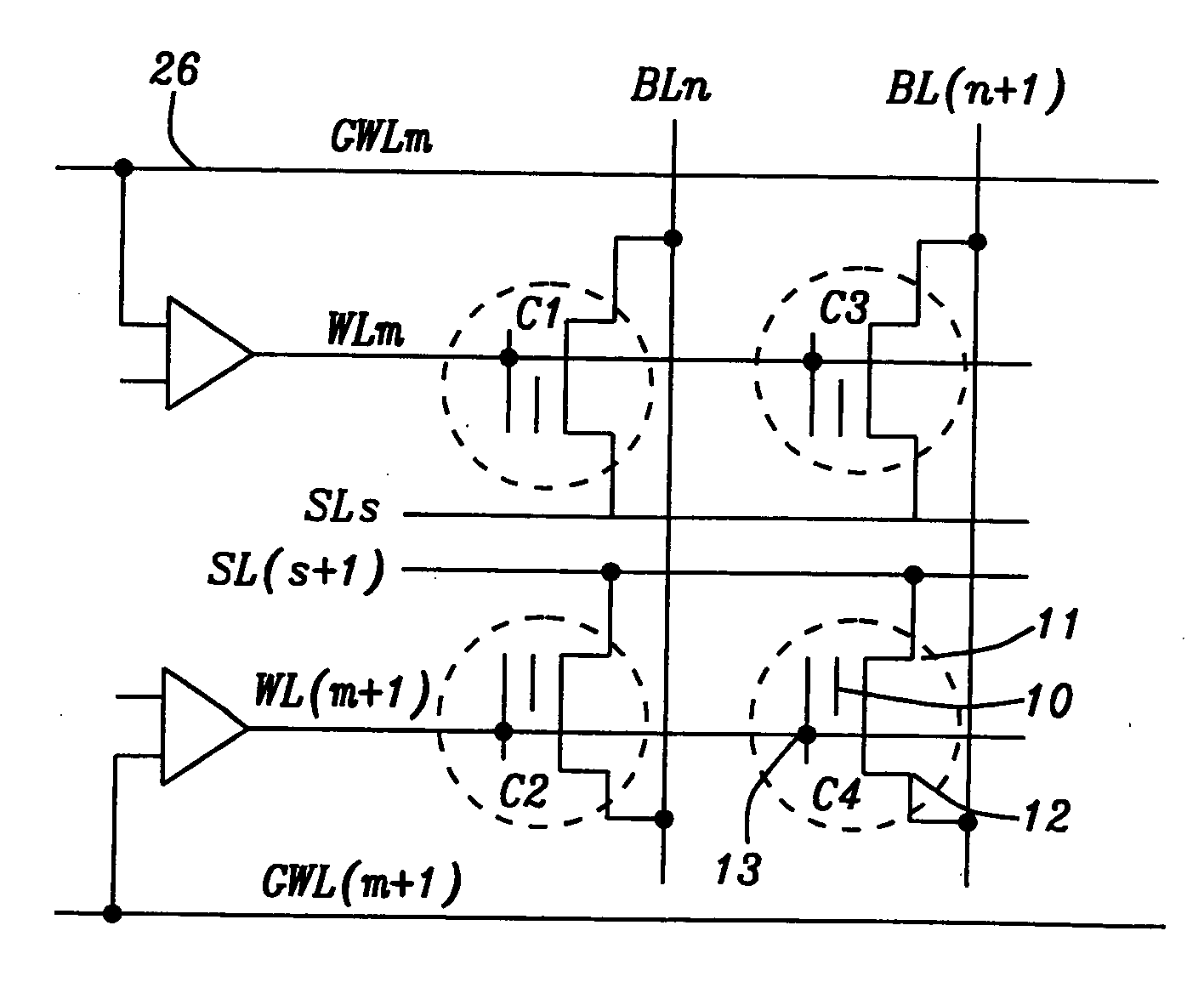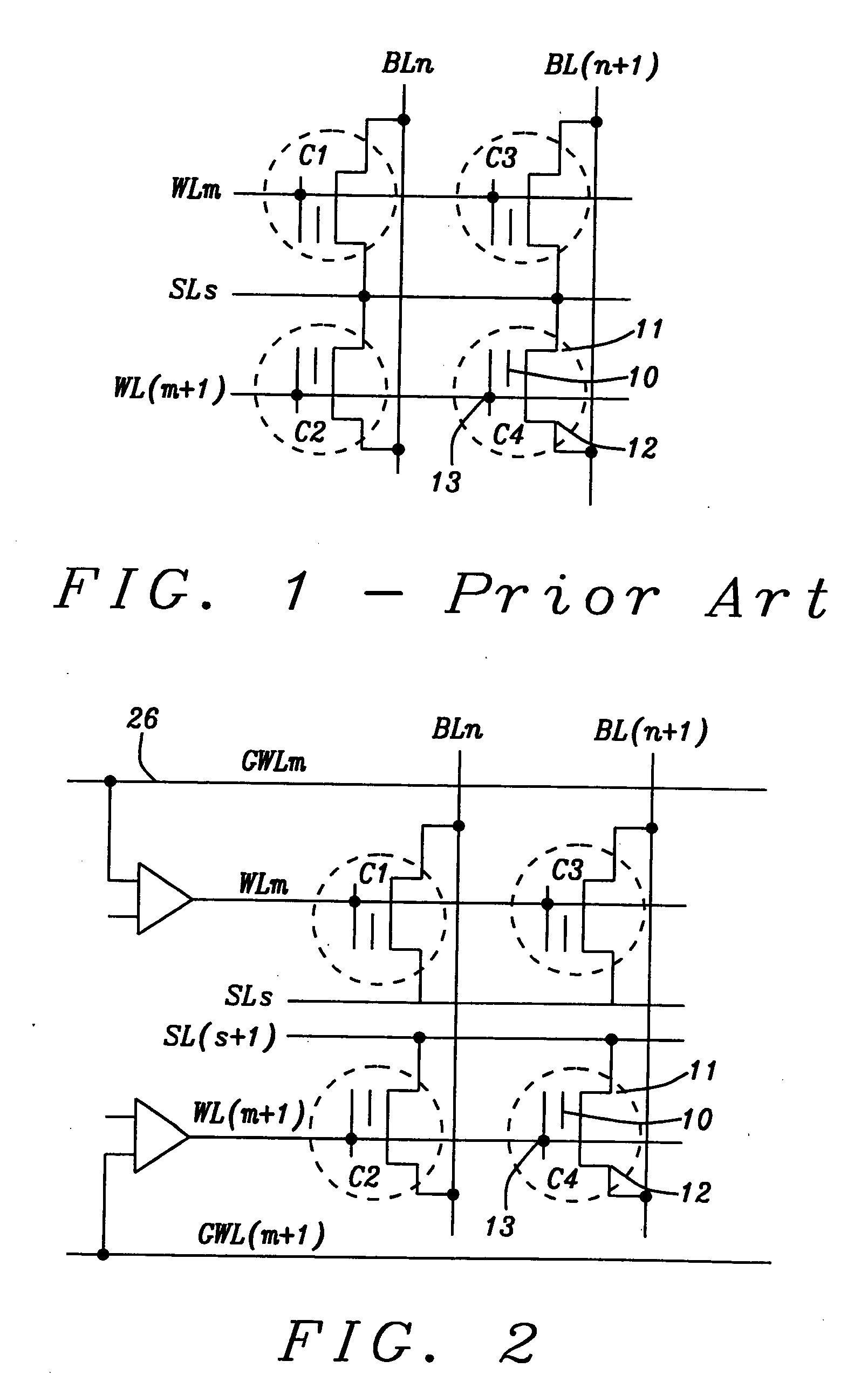Floating gate memory with split-gate read transistor and split gate program transistor memory cells and method for making the same
a technology of program transistors and floating gate memory, which is applied in the field of semiconductor memory, can solve the problems of increasing the amount of semiconductor real estate required to implement byte alterable memory, and cost sensitive, and achieves the effects of preventing punching, reducing the number of transistors, and eliminating reverse tunneling
- Summary
- Abstract
- Description
- Claims
- Application Information
AI Technical Summary
Benefits of technology
Problems solved by technology
Method used
Image
Examples
first embodiment
[0036] In FIG. 2 is shown a portion of a memory array of the present invention containing cells C1, C2, C3, and C4 with a single split gate transistor. The control gates 13 of the odd designated cells C1 and C3 are coupled to a local word line WLm and the control gates 13 of the even designated cells C2 and C4 are coupled to a local word line WL(m+1). The local word lines WLm and WL(m+1) are driven by word line drivers 25 which are connected to global word lines GWLm and GWL(m+1). The global word line 26 can be effectively segmented into small segments such as a byte length using a plurality of word line drivers 25 along a row of memory cells to drive each segment of cells. The source line connecting the odd cells and the even cells are separated into a source line SLs coupled to cells C1 and C3 and source line SL(s+1) coupled to cells C2 and C4. If cell C3 is selected to be programmed, The selected local word line WLm voltage is at approximately +1.8V, the voltage of unselected wor...
second embodiment
[0037] the present invention is described with respect to FIG. 3 and FIG. 4. FIG. 3 shows the plan view of the layout of two vertically adjacent cells C3 and C4. FIG. 4 shows a schematic diagram of a portion of an array of nonvolatile cells C1, C2, C3 and C4. The reference numbers in FIG. 3 and FIG. 4 correspond to each other and will be used to describe the layout and interconnections of the cells.
[0038] Continuing to reference FIGS. 3 and 4, each cell C1, C2, C3 and C4 comprise two split gate transistors that are coupled together by a shared, or merged, floating gate 14. Two bit lines 15 and 16 connect between cells in a column, which are connected to the drains 12 of the transistors by contacts 19. Cells C1 and C2 are connected by bit lines BLp(n) 16, a program bit line, and BLr(n) 15, a read bit line. Cells C3 and C4 are connected by bit lines BLp(n+1) 16, a program bit line, and BLr(n+1) 15, a read bit line. A word line WLm 21 connects to the control gates 13 in a row of cells ...
third embodiment
[0039] A third embodiment is shown in FIG. 5A in which there are two three-transistor cells C3 and C4 oriented one above the other in a column. The corresponding schematic diagram is shown in FIG. 6. There are three bit lines, two program bit lines 31 and 33 and one read bit line 32. In FIG. 6 the program bit lines are designated as BLp0(n) 34, BLp1(n) 36, BLp0(n+1) 31 and BLp1 (n+1) 33, and the read bit lines are designated as Blr(n) 35 and BLr(n+1) 32. Each cell C1, C2, C3 and C4 contain two split gate transistors, which have a merged floating gate 37. The third transistor in each cell is a split gate transistor separate from the other two and having a self-contained floating gate 38. The third transistor provides a “dummy” function that distributes capacitive loading on the program bit lines. Cells C3 and C4 are reversed mirror images of each other such that the “dummy” transistor is located at the upper right and lower left in FIG. 5A, and identified by the floating gate 38. The...
PUM
 Login to View More
Login to View More Abstract
Description
Claims
Application Information
 Login to View More
Login to View More - R&D
- Intellectual Property
- Life Sciences
- Materials
- Tech Scout
- Unparalleled Data Quality
- Higher Quality Content
- 60% Fewer Hallucinations
Browse by: Latest US Patents, China's latest patents, Technical Efficacy Thesaurus, Application Domain, Technology Topic, Popular Technical Reports.
© 2025 PatSnap. All rights reserved.Legal|Privacy policy|Modern Slavery Act Transparency Statement|Sitemap|About US| Contact US: help@patsnap.com



